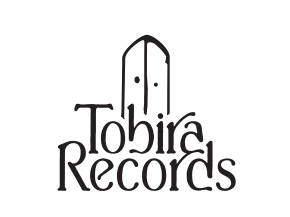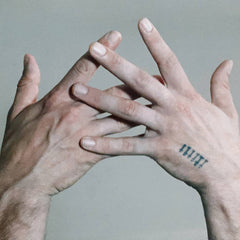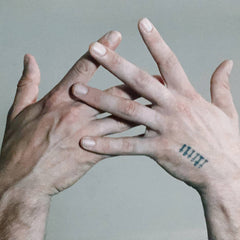Delphine Dora // L'inattingible LP
- Availability:
フランス・パリの即興演者/作曲家Delphine Doraが、2020年にリリースしたレコードです。様々な演者とコラボレーションしたドローンポップ〜ジャズドローン21曲を収録。
以下、レーベルによる解説です。
L'Inattingibleで、デルフィーヌ・ドラの音楽は新しい色彩のパレットを駆使して展開される。これまで外国語で、あるいは拡張された発声法で歌ってきた音楽家が、初めてフランス語だけを使うようになったこと、他の作家のテキストや詩をしばしば音楽にしてきた彼女が、ここでは自分のテキストや断片を歌うことを自認していることは、誰の目にも明らかであろう。
しかし、こうした形式的な充実だけでなく、『L'Inattingible』で展開された新しい音楽的野心は、このレコードの構造そのものに見出すことができる。前作が即興や自然発生的な作曲によって構想されたとすれば、新作は長い時間をかけて照合、書き直し、さまざまな変形を経て、決定的な姿になったのである。さらに、作曲の過程では、テキスト、音、楽器の複雑なモンタージュが行われるようになった。キーボードがレコードの消えない肺であるならば、デルフィーヌの歌声に出会い、それが豊かな楽器編成に反響することはもはや珍しいことではない。
彼女の音楽の新たな魅力は、アルバムに散りばめられた多くの参加者が、作品に独特の色合いを与えていることにあるようだ。管楽器、弦楽器、電子楽器、多数の鍵盤楽器、珍しい楽器、あらゆる種類の不調和な音など、作品ごとに異なる編成の30以上の楽器を聴くことができます。その中には、アビー・ヴリアミーのヴィオラ、アコーディオン、ミュージカル・ソー(Nalle、The One Ensemble.... )、アダム・カデルのヴァイオリン、スーザン・マシューズのハルモニウム、タラリー・ピーターソンのサックス(Spires That In The Sunset Rise)、ル・フルーツ・ヴェールのアナログシンセサイザー、ヴァレリー・ルクレックのパーカッションとフルート(Half Asleep)などがある。パウロ・シャガスのオーボエとクラリネット、ラウラ・ナウッカリネン(ラウ・ナウ)、ケイティ・シェイファー(オルデン・ヨーク)、ジャッキー・マクダウェルの声、トム・ジェームス・スコットの幽玄なピアノ、シルヴィア・ハレットの自転車の車輪やハーディガーディ、ゲイリー・ブロガンの彫刻的な音(Pefkin)などが登場する。つまり、2000年代以降、フォークやサイケデリック音楽、即興音楽や実験音楽の分野からインスピレーションを得て、音の領域を拡大し、実験を続けてきたミュージシャンの集団である。
このレコードは、これらの異なる参加者の存在によってのみ実現されたことを強調しなければならない。ちなみに、このアルバムの強さのすべては、この "inattingible "を形づくるパラドックスにある。それは、存在と不在の間で絶えず流動する一連の行為によってのみ自己主張するように見えるため、いっそう捉えどころがない。常に互いに擦れ合うこれらの音体は,聴きながら,私たちにとって身近でありながら異質でもある「もう一つの」空間の輪郭をなぞるようになる.このように、このアルバムの制作には多くのミュージシャンが参加していることが示唆するのとは逆に、このアルバムは不在のものを聴かせる能力を常に更新することにそのエネルギーを見出すことができる。この不在は確かに演奏されるのではなく、存在として、私たちの知覚の端に位置し、予測できない可能性に満ちた「horizon inconnu」(未知の地平線)のようなものとして作用するのである。
デルフィーヌは "Loin"(Far)という作品において、「私たちの前に現れたことのないものをどう表現したらいいのか」と自問している。もちろん、この問いに明確な答えはない。おそらくは、「不可解なもの」の入り口にいるからこそ、より魅力的な他の生命体を垣間見ることができる「埋もれた感覚」を、音楽家とリスナーの誰もが掘り起こすことを要求する、「なる過程」にある集団への確信だけだろう。
----------------------
three:four records:
"With L’Inattingible, Delphine Dora’s music unfolds by drawing upon a new palette of colors. It will not escape anyone, that after having sung, in foreign, invented languages, or through extended vocal techniques, the musician resorts for the first time, to solely using the French language; and that after having often set texts and poems by other authors to music, she authorizes herself here to sing her own texts and fragments.
But beyond these formal enrichments, the new musical ambitions developed through L'Inattingible are to be found in the very fabric of the record. If the previous albums had been conceived through improvisations or spontaneous compositions, the new pieces have found their definitive incarnations through a lengthy process of collation, rewriting, and a multitude of transformations. Moreover, the composition process now involves a complex montage of texts, sounds and instruments. If the keyboard remains the inextinguishable lung of the record, it is no longer rare to come upon Delphine's sung lines and have them echo into a lush instrumentation - where in voices and instruments create a language, and develop dialogues that have never been heard before.
The new charm of her music seems to lie in the many participations that punctuate the album, giving her pieces their very particular colourations. We can hear no less than thirty instruments with configurations that differ from one piece to another: wind and string instruments, electronic instruments, a multitude of keyboard sounds, unusual instruments and all kinds of incongruous sonorities. Among them are Aby Vulliamy’s viola, accordion and musical saw (Nalle, The One Ensemble...), Adam Cadell’s violin, Susan Matthews’ harmonium, Taralie Peterson’s saxophone (Spires That In The Sunset Rise), Le Fruit Vert’s analog synthesizers, Valérie Leclercq’s percussion and flute (Half Asleep), Paulo Chagas' oboe and clarinet, the voices of Laura Naukkkarinen (Lau Nau), Caity Shaffer (Olden Yolk) and Jackie McDowell, Tom James Scott's ghostly piano, Sylvia Hallett's bicycle wheel or hurdy-gurdy, or Gayle Brogan's sculpted sounds (Pefkin). That is: a constellation of musicians who have never ceased to expand their sonic territories, experimenting throughout the years since the 2000s, drawing inspiration from folk or psychedelic music as well as from the field of improvised or experimental music.
It must be highlighted, the extent to which this record could only come into being through the presence of these different participants. Incidentally, all of its strength lies in a paradox that gives shape to this "inattingible”, which is all the more elusive because it seems to only assert itself only through a series of actions engaged in a continual flux between presence and absence. Constantly brushing against each other, these sound bodies come to trace, as we listen, the contours of an "other" space that is both familiar and foreign to us. Thus, and contrary to what might be suggested by the participation of such a large number of musicians in the elaboration of the album, it finds its energy in this constantly renewed capacity to make the absent heard. This absence is certainly not played, but acts as a presence, a kind of “horizon inconnu” (unknown horizon) situated at the edge of our perception, abounding in unpredictable potentialities.
"How to describe what has never appeared to us," Delphine asks herself on the piece entitled "Loin" (Far). There is, of course, no definitive answer to this question. Perhaps only the belief in a collective that is in the process of becoming, that, through the forms of engagement requires that everyone (musicians and listeners) unearths all of the “sensations enfouies” (buried sensations) that allow us to catch a glimpse of other forms of life that are all the more fascinating, because they remain on the threshold of the “l’inexplicable". "
Artist : Delphine Dora
Label : three:four records
フランス・パリの即興演者/作曲家Delphine Doraが、2020年にリリースしたレコードです。様々な演者とコラボレーションしたドローンポップ〜ジャズドローン21曲を収録。
以下、レーベルによる解説です。
L'Inattingibleで、デルフィーヌ・ドラの音楽は新しい色彩のパレットを駆使して展開される。これまで外国語で、あるいは拡張された発声法で歌ってきた音楽家が、初めてフランス語だけを使うようになったこと、他の作家のテキストや詩をしばしば音楽にしてきた彼女が、ここでは自分のテキストや断片を歌うことを自認していることは、誰の目にも明らかであろう。
しかし、こうした形式的な充実だけでなく、『L'Inattingible』で展開された新しい音楽的野心は、このレコードの構造そのものに見出すことができる。前作が即興や自然発生的な作曲によって構想されたとすれば、新作は長い時間をかけて照合、書き直し、さまざまな変形を経て、決定的な姿になったのである。さらに、作曲の過程では、テキスト、音、楽器の複雑なモンタージュが行われるようになった。キーボードがレコードの消えない肺であるならば、デルフィーヌの歌声に出会い、それが豊かな楽器編成に反響することはもはや珍しいことではない。
彼女の音楽の新たな魅力は、アルバムに散りばめられた多くの参加者が、作品に独特の色合いを与えていることにあるようだ。管楽器、弦楽器、電子楽器、多数の鍵盤楽器、珍しい楽器、あらゆる種類の不調和な音など、作品ごとに異なる編成の30以上の楽器を聴くことができます。その中には、アビー・ヴリアミーのヴィオラ、アコーディオン、ミュージカル・ソー(Nalle、The One Ensemble.... )、アダム・カデルのヴァイオリン、スーザン・マシューズのハルモニウム、タラリー・ピーターソンのサックス(Spires That In The Sunset Rise)、ル・フルーツ・ヴェールのアナログシンセサイザー、ヴァレリー・ルクレックのパーカッションとフルート(Half Asleep)などがある。パウロ・シャガスのオーボエとクラリネット、ラウラ・ナウッカリネン(ラウ・ナウ)、ケイティ・シェイファー(オルデン・ヨーク)、ジャッキー・マクダウェルの声、トム・ジェームス・スコットの幽玄なピアノ、シルヴィア・ハレットの自転車の車輪やハーディガーディ、ゲイリー・ブロガンの彫刻的な音(Pefkin)などが登場する。つまり、2000年代以降、フォークやサイケデリック音楽、即興音楽や実験音楽の分野からインスピレーションを得て、音の領域を拡大し、実験を続けてきたミュージシャンの集団である。
このレコードは、これらの異なる参加者の存在によってのみ実現されたことを強調しなければならない。ちなみに、このアルバムの強さのすべては、この "inattingible "を形づくるパラドックスにある。それは、存在と不在の間で絶えず流動する一連の行為によってのみ自己主張するように見えるため、いっそう捉えどころがない。常に互いに擦れ合うこれらの音体は,聴きながら,私たちにとって身近でありながら異質でもある「もう一つの」空間の輪郭をなぞるようになる.このように、このアルバムの制作には多くのミュージシャンが参加していることが示唆するのとは逆に、このアルバムは不在のものを聴かせる能力を常に更新することにそのエネルギーを見出すことができる。この不在は確かに演奏されるのではなく、存在として、私たちの知覚の端に位置し、予測できない可能性に満ちた「horizon inconnu」(未知の地平線)のようなものとして作用するのである。
デルフィーヌは "Loin"(Far)という作品において、「私たちの前に現れたことのないものをどう表現したらいいのか」と自問している。もちろん、この問いに明確な答えはない。おそらくは、「不可解なもの」の入り口にいるからこそ、より魅力的な他の生命体を垣間見ることができる「埋もれた感覚」を、音楽家とリスナーの誰もが掘り起こすことを要求する、「なる過程」にある集団への確信だけだろう。
----------------------
three:four records:
"With L’Inattingible, Delphine Dora’s music unfolds by drawing upon a new palette of colors. It will not escape anyone, that after having sung, in foreign, invented languages, or through extended vocal techniques, the musician resorts for the first time, to solely using the French language; and that after having often set texts and poems by other authors to music, she authorizes herself here to sing her own texts and fragments.
But beyond these formal enrichments, the new musical ambitions developed through L'Inattingible are to be found in the very fabric of the record. If the previous albums had been conceived through improvisations or spontaneous compositions, the new pieces have found their definitive incarnations through a lengthy process of collation, rewriting, and a multitude of transformations. Moreover, the composition process now involves a complex montage of texts, sounds and instruments. If the keyboard remains the inextinguishable lung of the record, it is no longer rare to come upon Delphine's sung lines and have them echo into a lush instrumentation - where in voices and instruments create a language, and develop dialogues that have never been heard before.
The new charm of her music seems to lie in the many participations that punctuate the album, giving her pieces their very particular colourations. We can hear no less than thirty instruments with configurations that differ from one piece to another: wind and string instruments, electronic instruments, a multitude of keyboard sounds, unusual instruments and all kinds of incongruous sonorities. Among them are Aby Vulliamy’s viola, accordion and musical saw (Nalle, The One Ensemble...), Adam Cadell’s violin, Susan Matthews’ harmonium, Taralie Peterson’s saxophone (Spires That In The Sunset Rise), Le Fruit Vert’s analog synthesizers, Valérie Leclercq’s percussion and flute (Half Asleep), Paulo Chagas' oboe and clarinet, the voices of Laura Naukkkarinen (Lau Nau), Caity Shaffer (Olden Yolk) and Jackie McDowell, Tom James Scott's ghostly piano, Sylvia Hallett's bicycle wheel or hurdy-gurdy, or Gayle Brogan's sculpted sounds (Pefkin). That is: a constellation of musicians who have never ceased to expand their sonic territories, experimenting throughout the years since the 2000s, drawing inspiration from folk or psychedelic music as well as from the field of improvised or experimental music.
It must be highlighted, the extent to which this record could only come into being through the presence of these different participants. Incidentally, all of its strength lies in a paradox that gives shape to this "inattingible”, which is all the more elusive because it seems to only assert itself only through a series of actions engaged in a continual flux between presence and absence. Constantly brushing against each other, these sound bodies come to trace, as we listen, the contours of an "other" space that is both familiar and foreign to us. Thus, and contrary to what might be suggested by the participation of such a large number of musicians in the elaboration of the album, it finds its energy in this constantly renewed capacity to make the absent heard. This absence is certainly not played, but acts as a presence, a kind of “horizon inconnu” (unknown horizon) situated at the edge of our perception, abounding in unpredictable potentialities.
"How to describe what has never appeared to us," Delphine asks herself on the piece entitled "Loin" (Far). There is, of course, no definitive answer to this question. Perhaps only the belief in a collective that is in the process of becoming, that, through the forms of engagement requires that everyone (musicians and listeners) unearths all of the “sensations enfouies” (buried sensations) that allow us to catch a glimpse of other forms of life that are all the more fascinating, because they remain on the threshold of the “l’inexplicable". "
Artist : Delphine Dora
Label : three:four records






![Wishy // Paradise On Planet Popstar TAPE [PRE-ORDER]](http://tobirarecords.com/cdn/shop/files/pl1_26095880-d95d-4481-a68b-9d7110db2e5c_medium.jpg?v=1743983748)
![Wishy // Paradise On Planet Popstar CD [PRE-ORDER]](http://tobirarecords.com/cdn/shop/files/pl1_1cac0212-9e69-47d0-abe6-aa342d76ae31_medium.jpg?v=1743983660)